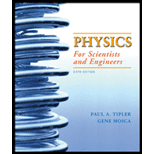
(a)
The battery current just after closing switch S.
(a)
Answer to Problem 103P
The battery current just after closing the switch S is
Explanation of Solution
Given:
The value of emf is
The value of capacitances are
Formula used:
Apply Kirchhoff’s rule in circuit just after switch is closed,
Here,
Calculation:
Initially, the capacitor is uncharged so,
From equation (1), the battery current just after closing switch S is calculated as,
Conclusion:
Therefore, the battery current just after closing the switch S is
(b)
The battery current a long time after closing the switch S.
(b)
Answer to Problem 103P
The battery current a long time after closing the switch S is
Explanation of Solution
Formula used:
Apply Kirchhoff’s rule in circuit a long time after switch is closed,
Here,
Calculation:
From equation (2), the battery current a long time after closing switch S is calculated as,
Conclusion:
Therefore, the battery current a long time after closing the switch S is
(c)
The current in
(c)
Answer to Problem 103P
The current in
Explanation of Solution
Formula used:
Apply Kirchhoff’s rule at j unction of resistor
Apply Kirchhoff’s rule in loop 1,
Apply Kirchhoff’s rule in loop containing resistor
Calculation:
Differentiate equation (4) with respect to time,
Differentiate equation (5) with respect to time,
From equation (3) and (7),
From equation (4),
From equation (8) and (9),
Let the solution of above differential equation is,
Differentiate equation (10) with respect to time,
From equation (8) and (11),
Equate coefficient of
And,
At
From equation (10),
From equation (10),
Substitute values in equation (13),
Conclusion:
Therefore, the current in
(d)
The charges on capacitors plates a long time after reopening the switch S.
(d)
Answer to Problem 103P
The charges on capacitors plates a long time after reopening the switch S is zero.
Explanation of Solution
Calculation:
If the switch S is reopened, then after long time there will not be any flow of current in the circuit. Thus,
The potential difference across
The charges on
Conclusion:
Therefore, the charges on capacitors plates a long time after reopening the switch S is zero.
Want to see more full solutions like this?
Chapter 25 Solutions
EBK PHYSICS FOR SCIENTISTS AND ENGINEER
- A 0.850-m-long metal bar is pulled to the right at a steady 5.0 m/s perpendicular to a uniform, 0.650-T magnetic field. The bar rides on parallel metal rails connected through a 25-Ω, resistor (Figure 1), so the apparatus makes a complete circuit. Ignore the resistance of the bar and the rails. Please explain how to find the direction of the induced current.arrow_forwardFor each of the actions depicted, determine the direction (right, left, or zero) of the current induced to flow through the resistor in the circuit containing the secondary coil. The coils are wrapped around a plastic core. Immediately after the switch is closed, as shown in the figure, (Figure 1) in which direction does the current flow through the resistor? If the switch is then opened, as shown in the figure, in which direction does the current flow through the resistor? I have the answers to the question, but would like to understand the logic behind the answers. Please show steps.arrow_forwardWhen violet light of wavelength 415 nm falls on a single slit, it creates a central diffraction peak that is 8.60 cm wide on a screen that is 2.80 m away. Part A How wide is the slit? ΟΙ ΑΣΦ ? D= 2.7.10-8 Submit Previous Answers Request Answer × Incorrect; Try Again; 8 attempts remaining marrow_forward
- Two complex values are z1=8 + 8i, z2=15 + 7 i. z1∗ and z2∗ are the complex conjugate values. Any complex value can be expessed in the form of a+bi=reiθ. Find θ for (z1-z∗2)/z1+z2∗. Find r and θ for (z1−z2∗)z1z2∗ Please show all stepsarrow_forwardCalculate the center of mass of the hollow cone shown below. Clearly specify the origin and the coordinate system you are using. Z r Y h Xarrow_forward12. If all three collisions in the figure below are totally inelastic, which will cause more damage? (think about which collision has a larger amount of kinetic energy dissipated/lost to the environment? I m II III A. I B. II C. III m m v brick wall ע ע 0.5v 2v 0.5m D. I and II E. II and III F. I and III G. I, II and III (all of them) 2marrow_forward
- 11. If all three collisions in the figure below are totally inelastic, which brings the car of mass (m) on the left to a halt? I m II III m m ע ע ע brick wall 0.5v 2m 2v 0.5m A. I B. II C. III D. I and II E. II and III F. I and III G. I, II and III (all of them)arrow_forwardHow can you tell which vowel is being produced here ( “ee,” “ah,” or “oo”)? Also, how would you be able to tell for the other vowels?arrow_forwardYou want to fabricate a soft microfluidic chip like the one below. How would you go about fabricating this chip knowing that you are targeting a channel with a square cross-sectional profile of 200 μm by 200 μm. What materials and steps would you use and why? Disregard the process to form the inlet and outlet. Square Cross Sectionarrow_forward
 Principles of Physics: A Calculus-Based TextPhysicsISBN:9781133104261Author:Raymond A. Serway, John W. JewettPublisher:Cengage Learning
Principles of Physics: A Calculus-Based TextPhysicsISBN:9781133104261Author:Raymond A. Serway, John W. JewettPublisher:Cengage Learning College PhysicsPhysicsISBN:9781305952300Author:Raymond A. Serway, Chris VuillePublisher:Cengage Learning
College PhysicsPhysicsISBN:9781305952300Author:Raymond A. Serway, Chris VuillePublisher:Cengage Learning College PhysicsPhysicsISBN:9781285737027Author:Raymond A. Serway, Chris VuillePublisher:Cengage Learning
College PhysicsPhysicsISBN:9781285737027Author:Raymond A. Serway, Chris VuillePublisher:Cengage Learning Glencoe Physics: Principles and Problems, Student...PhysicsISBN:9780078807213Author:Paul W. ZitzewitzPublisher:Glencoe/McGraw-Hill
Glencoe Physics: Principles and Problems, Student...PhysicsISBN:9780078807213Author:Paul W. ZitzewitzPublisher:Glencoe/McGraw-Hill
 Physics for Scientists and Engineers: Foundations...PhysicsISBN:9781133939146Author:Katz, Debora M.Publisher:Cengage Learning
Physics for Scientists and Engineers: Foundations...PhysicsISBN:9781133939146Author:Katz, Debora M.Publisher:Cengage Learning





